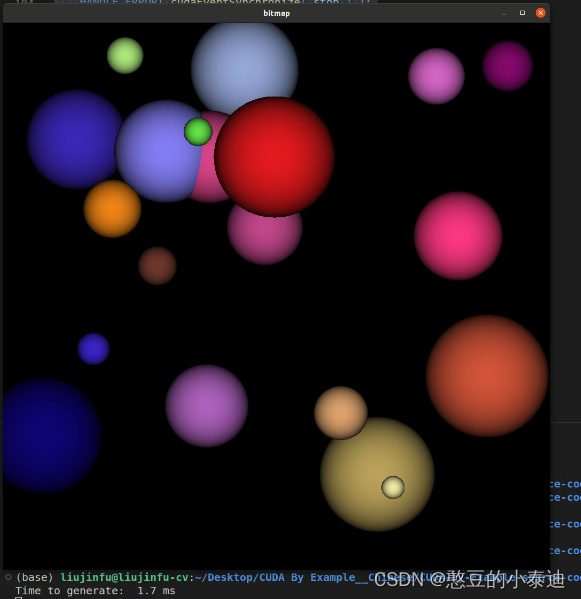目录
1--常量内存
CUDA C支持使用常量内存,其用于保存核函数执行期间不发生变化的数据;使用常量内存可以有效节省内存带宽,其原因在于:
对常量内存的单次读操作可以广播到其他临近的线程,节约临近线程的读取操作;
常量内存的数据将被缓存,对相同地址的连续读操作不会产生额外的内存通信量;
在CUDA架构中,线程束是指一个包含32个线程的集合;当处理常量内存时,NVIDIA硬件将单次内存读取操作广播到半线程束中(16个线程);当半线程束的每个线程都从常量内存相同地址读取数据时,GPU只会产生一次读取请求并将数据广播到每个线程中;因此,当从常量内存中读取大量数据时,产生的内存流量仅为使用全局变量的1/16;
// 在变量前面加上__constant__修饰符来声明常量内存
// 将常量内存从主机内存复制到 GPU 中,使用cudaMemcpyToSymbol()2--事件
CUDA事件的本质是一个 GPU 时间戳,其在用户指定的时间点上被记录;
扫描二维码关注公众号,回复:
14869921 查看本文章


// 使用 cudaEvent_t 声明事件
cudaEvent_t start;
// 使用 cudaEventCreate() 记录事件
cudaEventCreate(&start);
// 使用 cudaEventRecord() 记录事件
cudaEventRecord(start, 0)统计一段代码的执行时间,需要创建一个起始事件和一个结束事件:
cudaEvent_t start, stop;
cudaEventCreate(&start);
cudaEventCreate(&stop);
cudaEventRecord(start, 0);
// Code..
cudaEventRecord(stop, 0);
cudaEventSynchronize(stop);cudaEventSynchronize() 用于事件同步,其阻塞后面的语句直到事件结束;
3--光线跟踪实例
#include "cuda.h"
#include "../common/book.h"
#include "../common/cpu_bitmap.h"
#define DIM 1024
#define rnd( x ) (x * rand() / RAND_MAX)
#define INF 2e10f
struct Sphere {
float r,b,g;
float radius;
float x,y,z;
__device__ float hit( float ox, float oy, float *n ) {
float dx = ox - x;
float dy = oy - y;
if (dx*dx + dy*dy < radius*radius) {
float dz = sqrtf( radius*radius - dx*dx - dy*dy );
*n = dz / sqrtf( radius * radius );
return dz + z;
}
return -INF;
}
};
#define SPHERES 20
__constant__ Sphere s[SPHERES];
__global__ void kernel( unsigned char *ptr ) {
// map from threadIdx/BlockIdx to pixel position
int x = threadIdx.x + blockIdx.x * blockDim.x;
int y = threadIdx.y + blockIdx.y * blockDim.y;
int offset = x + y * blockDim.x * gridDim.x;
float ox = (x - DIM/2);
float oy = (y - DIM/2);
float r=0, g=0, b=0;
float maxz = -INF;
for(int i=0; i<SPHERES; i++) {
float n;
float t = s[i].hit( ox, oy, &n );
if (t > maxz) {
float fscale = n;
r = s[i].r * fscale;
g = s[i].g * fscale;
b = s[i].b * fscale;
maxz = t;
}
}
ptr[offset*4 + 0] = (int)(r * 255);
ptr[offset*4 + 1] = (int)(g * 255);
ptr[offset*4 + 2] = (int)(b * 255);
ptr[offset*4 + 3] = 255;
}
// globals needed by the update routine
struct DataBlock {
unsigned char *dev_bitmap;
};
int main( void ) {
DataBlock data;
// capture the start time
cudaEvent_t start, stop;
HANDLE_ERROR( cudaEventCreate( &start ) );
HANDLE_ERROR( cudaEventCreate( &stop ) );
HANDLE_ERROR( cudaEventRecord( start, 0 ) );
CPUBitmap bitmap( DIM, DIM, &data );
unsigned char *dev_bitmap;
// allocate memory on the GPU for the output bitmap
HANDLE_ERROR( cudaMalloc( (void**)&dev_bitmap,
bitmap.image_size() ) );
// allocate temp memory, initialize it, copy to constant
// memory on the GPU, then free our temp memory
Sphere *temp_s = (Sphere*)malloc( sizeof(Sphere) * SPHERES );
for (int i=0; i<SPHERES; i++) {
temp_s[i].r = rnd( 1.0f );
temp_s[i].g = rnd( 1.0f );
temp_s[i].b = rnd( 1.0f );
temp_s[i].x = rnd( 1000.0f ) - 500;
temp_s[i].y = rnd( 1000.0f ) - 500;
temp_s[i].z = rnd( 1000.0f ) - 500;
temp_s[i].radius = rnd( 100.0f ) + 20;
}
HANDLE_ERROR( cudaMemcpyToSymbol( s, temp_s,
sizeof(Sphere) * SPHERES) );
free( temp_s );
// generate a bitmap from our sphere data
dim3 grids(DIM/16,DIM/16);
dim3 threads(16,16);
kernel<<<grids,threads>>>( dev_bitmap );
// copy our bitmap back from the GPU for display
HANDLE_ERROR( cudaMemcpy( bitmap.get_ptr(), dev_bitmap,
bitmap.image_size(),
cudaMemcpyDeviceToHost ) );
// get stop time, and display the timing results
HANDLE_ERROR( cudaEventRecord( stop, 0 ) );
HANDLE_ERROR( cudaEventSynchronize( stop ) );
float elapsedTime;
HANDLE_ERROR( cudaEventElapsedTime( &elapsedTime,
start, stop ) );
printf( "Time to generate: %3.1f ms\n", elapsedTime );
HANDLE_ERROR( cudaEventDestroy( start ) );
HANDLE_ERROR( cudaEventDestroy( stop ) );
HANDLE_ERROR( cudaFree( dev_bitmap ) );
// display
bitmap.display_and_exit();
}